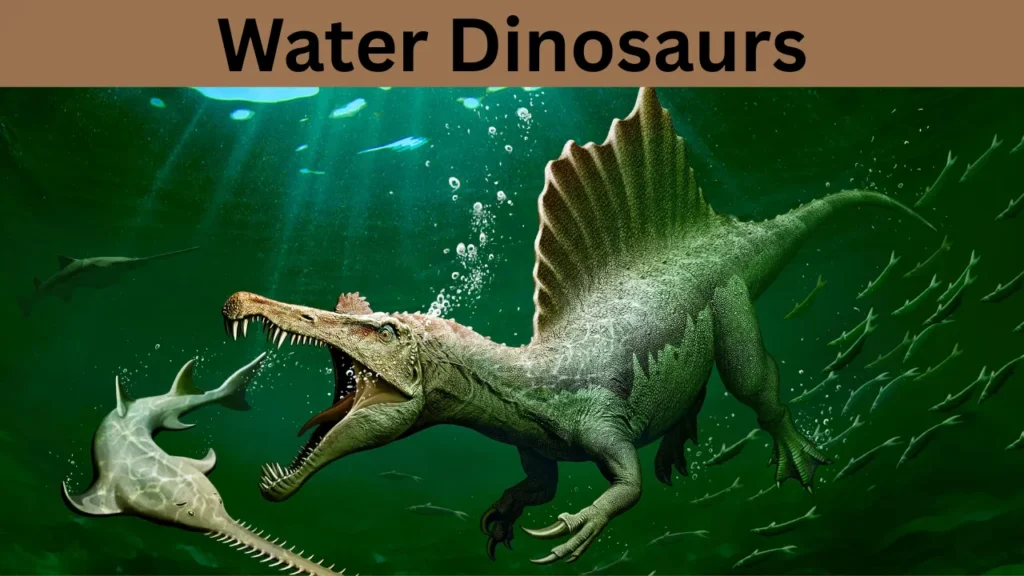Although not true dinosaurs, these creatures—like Mosasaurus, Plesiosaurus, and Ichthyosaurus—were apex predators in their aquatic habitats. The title emphasizes their majestic role in shaping marine life millions of years ago. It also sparks curiosity by blending the familiar term “dinosaurs” with their lesser-known oceanic counterparts, inviting readers to explore the mystery, evolution, and might of these prehistoric sea giants.
Also Read: cenpok.com
What Are Water Dinosaurs?
When people talk about water dinosaurs, they usually mean the large, fierce sea creatures that lived during the same era as land dinosaurs. Although not true dinosaurs, these reptiles ruled the oceans with powerful jaws, streamlined bodies, and impressive swimming skills. They were marine reptiles that shared Earth with dinosaurs but evolved along a separate path.
The term dinosaurs is popular because it helps people visualize these ocean-dwelling beasts. However, scientists call them marine reptiles. Creatures like Plesiosaurus, Mosasaurus, and Ichthyosaurus fall into this category. These animals lived millions of years ago, long before humans existed.
Also Read: www gravityinternetnet: Fast and Affordable Internet Service
Evolution of Water Dinosaurs
Marine reptiles evolved from land-dwelling reptiles that returned to the water. This adaptation happened gradually, allowing them to develop fins, flippers, and tails designed for swimming. Just like whales today, they breathed air but spent their entire lives in water.
The Mesozoic Era, which includes the Triassic, Jurassic, and Cretaceous periods, was when dinosaurs flourished. This era also gave rise to famous land dinosaurs, but the seas had their own giants. Marine reptiles became apex predators, feeding on fish, squid, and even other marine reptiles.
Also Read: FAQLogin.com Home Improvement: Tips for a Better Home
Types of Water Dinosaurs
There were several different kinds of marine reptiles, each with unique features. These creatures filled many ecological roles in prehistoric oceans. Some hunted in deep water, while others stayed near coastlines. The most well-known types of water dinosaurs include plesiosaurs, ichthyosaurs, and mosasaurs.
Let’s look at them in a simple table:
| Marine Reptile | Key Features | Era |
|---|---|---|
| Plesiosaurus | Long neck, small head, four flippers | Late Triassic to Cretaceous |
| Ichthyosaurus | Dolphin-shaped, big eyes, live birth | Early Jurassic |
| Mosasaurus | Massive body, sharp teeth, powerful tail | Late Cretaceous |
| Liopleurodon | Strong jaws, fast swimmer, short neck | Middle to Late Jurassic |
| Elasmosaurus | Extremely long neck, surface swimmer | Late Cretaceous |
Each species developed traits that helped them survive in different marine environments. Some chased fish with speed, while others ambushed prey using stealth.
Also Read: Alex Aniston: The Untold Story of Jennifer Aniston’s Half-Brother
Plesiosaurus: The Long-Necked Hunter
The Plesiosaurus is one of the most famous creatures called a water dinosaur. It had a small head, long neck, and four strong flippers. This body shape helped it glide smoothly through water. Its long neck allowed it to sneak up on prey, while its sharp teeth made quick work of fish and squid.
Many people confuse Plesiosaurus with the mythical Loch Ness Monster because they look similar. It’s easy to see why—both have long necks and flippers. In reality, Plesiosaurus lived about 200 million years ago and grew up to 15 feet long.
Also Read: Kashito: Meaning, Origin, and Online Presence
Mosasaurus: The Ocean Giant
One of the most terrifying water dinosaurs was the Mosasaurus. It could grow up to 50 feet long and had jaws filled with sharp, cone-shaped teeth. Unlike plesiosaurs, it had a short neck and a long, powerful tail that helped it move quickly through the water.
Mosasaurus appeared during the Late Cretaceous period. It was a top predator and even preyed on other marine reptiles. It also had a forked tongue and may have had a keen sense of smell. Some fossils suggest that it hunted in packs, making it even more dangerous.
Ichthyosaurus: The Dolphin-Like Swimmer
The Ichthyosaurus looked much like today’s dolphins but had a reptilian background. It had a long snout, strong tail, and smooth, torpedo-shaped body. It was built for speed, making it one of the fastest sea reptiles of its time.
Ichthyosaurs gave birth to live young instead of laying eggs. Fossil evidence shows baby ichthyosaurs inside their mothers, proving this rare trait. They lived mostly during the Jurassic period and hunted fish and squid in deep waters.
Fossils and Discoveries
Fossils of water dinosaurs have been found all over the world, including in Europe, North America, and South America. These fossils have helped scientists learn how marine reptiles lived and evolved. Some fossils are incredibly detailed, showing skin impressions, stomach contents, and even unborn babies.
For example, a fossil of a pregnant Ichthyosaurus revealed how these creatures reproduced. Mosasaurus fossils found in Kansas showed that ancient seas once covered the Midwest of the United States. These discoveries give us clues about how Earth’s continents and oceans have changed over time.
Water Dinosaurs vs. Land Dinosaurs
Although they lived at the same time, dinosaurs and land dinosaurs were very different. Land dinosaurs walked on legs and laid eggs on land. Water dinosaurs, or marine reptiles, had flippers and lived full-time in oceans. They breathed air but could not survive outside water.
Their diets also varied. Land dinosaurs ate plants or other land animals, while dinosaurs hunted fish, squid, and even other sea reptiles. Their bodies were shaped differently, too. Marine reptiles had streamlined shapes for swimming, unlike land dinosaurs with legs and tails for walking or running.
Pop Culture and Media
Water dinosaurs have become stars in movies, books, and video games. The Mosasaurus, for example, made a big splash in the Jurassic World movie series. People love these creatures because they combine the mystery of the deep sea with the danger of ancient predators.
Plesiosaurs often appear in documentaries and cartoons. Even if they aren’t true dinosaurs, their popularity continues to grow. Kids and adults alike are fascinated by their size, power, and mysterious behavior.
Extinction of Water Dinosaurs
Marine reptiles went extinct around the same time as land dinosaurs—about 66 million years ago. This mass extinction was likely caused by a giant asteroid hitting Earth, followed by massive climate changes. The impact threw up dust that blocked sunlight and cooled the planet, making it hard for marine ecosystems to survive.
Many sea animals died off, including fish, coral, and plankton. Without food, water dinosaurs couldn’t survive. Today, only their fossils remain, telling the story of a lost world beneath the waves.
Why We Study Water Dinosaurs
Studying water dinosaurs helps scientists understand how life on Earth has changed. These creatures show how animals can adapt to extreme environments. From fast swimmers to deep divers, marine reptiles show the wide range of survival strategies in the ocean.
Learning about them also helps paleontologists track changes in climate, sea levels, and biodiversity over millions of years. Their fossils are windows into ancient oceans, revealing what Earth looked like long ago.
Comparison of Major Water Dinosaurs
| Name | Size (Feet) | Diet | Time Period | Unique Trait |
|---|---|---|---|---|
| Plesiosaurus | 15 | Fish/Squid | Jurassic | Long neck, four flippers |
| Mosasaurus | 50+ | Carnivore | Cretaceous | Shark-like tail, big predator |
| Ichthyosaurus | 6-13 | Fish/Squid | Jurassic | Dolphin shape, live birth |
| Liopleurodon | 20-30 | Carnivore | Jurassic | Powerful jaws, strong swimmer |
| Elasmosaurus | 35-45 | Fish | Cretaceous | Longest neck among marine reptiles |
Conclusion
Even though they weren’t true dinosaurs, water dinosaurs were some of the most fearsome and fascinating animals to ever live. Their sleek shapes, powerful tails, and sharp teeth made them rulers of the ancient seas. From the fast Ichthyosaurus to the monstrous Mosasaurus, each species played a role in Earth’s prehistoric marine world.
Their fossils continue to teach us about evolution, extinction, and adaptation. Whether you’re a student, a fan of dinosaurs, or just curious about ancient life, dinosaurs offer a deep dive into Earth’s oceanic past.



